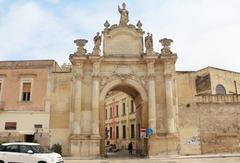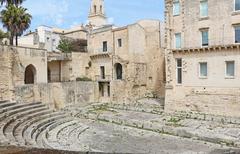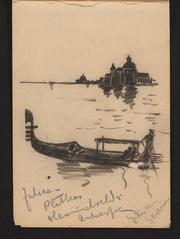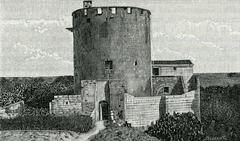Comprehensive Guide to Visiting Lecce, Italy
Date: 14/08/2024
Captivating Introduction
Welcome to Lecce, an enchanting city in the heart of Italy’s heel, where history and beauty intertwine to create a truly unique travel experience. Often referred to as ‘The Florence of the South,’ Lecce captivates visitors with its stunning Baroque architecture, vibrant cultural scene, and rich historical tapestry. Imagine wandering through cobblestone streets where every corner unveils a new story from the past, from ancient Roman amphitheaters to opulent Baroque churches. Lecce is not just a city; it’s an open-air museum, where each building, alley, and plaza has a tale to tell. (Wikipedia, Puglia Guys).
But Lecce is more than its historical grandeur. It’s a sensory delight where the aroma of freshly baked pasticciotto pastries mingles with the sound of church bells and the lively chatter of locals. The city’s golden-hued limestone buildings glow under the Mediterranean sun, casting a magical spell. Whether you’re exploring hidden gems like the underground Jewish Museum or savoring local delicacies at the Mercato di Lecce, every moment in Lecce is an invitation to dive deeper into its rich heritage and vibrant culture. (Understanding Italy, Butterfield)
Ready to embark on this adventure? Let’s uncover the secrets of Lecce together, where every step is a journey through time, every meal a celebration of local flavors, and every interaction a glimpse into the soul of this enchanting city.
Table of Contents
- Historical Background
- Ancient Origins and Roman Influence
- Byzantine and Norman Periods
- Medieval and Renaissance Periods
- Baroque Flourishing
- Hidden Gems and Local Secrets
- Sensory Descriptions
- Interactive Elements
- Cultural Context and Etiquette
- Practical Information with a Twist
- Pop Culture References
- Time-Based Itineraries
- Local Lingo Lessons
- Seasonal Highlights
- Myth Busting and Surprises
- Storytelling Elements
- FAQ
- A Journey Through Lecce, Italy: Baroque Beauty and Beyond
- Basilica di Santa Croce: The Baroque Marvel
- Piazza del Duomo: The Heartbeat of Lecce
- Roman Amphitheater: Echoes of Gladiators
- Church of Sant’Irene: The Patron’s Sanctuary
- Porta Napoli: Gate to the Past
- Palazzo dei Celestini: Monastic Marvel
- Roman Theatre: Echoes of Drama
- Museo Faggiano: A House of Secrets
- Piazza Sant’Oronzo: The Social Hub
- Castello di Carlo V: The Fortress of History
- Chiesa di San Matteo: The Elliptical Wonder
- Teatro Politeama Greco: The Cultural Stage
- Villa Comunale: Nature’s Retreat
- Museo Provinciale Sigismondo Castromediano: The Oldest Museum
- Chiesa di Santa Chiara: Baroque Beauty
- Palazzo Vernazza: An Architectural Treasure
- Chiesa del Gesù: The Grand Finale
- Visitor Tips: Insider Edition
- A Baroque Treasure Hunt: Your Ultimate Guide to Lecce, Italy
Historical Background of Lecce
Ancient Origins and Roman Influence
Welcome to Lecce, the dazzling jewel of the Salentine Peninsula! Imagine a city where ancient myths whisper through cobblestone streets and history comes alive at every corner. Did you know Lecce’s roots go back over two millennia? According to local lore, the city was founded by the Messapians, an ancient Italic tribe, during the era of the Trojan War (Wikipedia).
By the 3rd century BC, Lecce—then called Lupiae—was under Roman rule. The Romans, ever the urban planners, transformed it into a thriving metropolis. The visionary Emperor Hadrian moved the city three kilometers northeast, renaming it Litium. He even built a straight Roman road to connect Lecce to the Hadrian Port, now known as San Cataldo (Puglia Guys). Picture gladiators clashing in a 25,000-seater amphitheatre or citizens being mesmerized by theatrical performances (Understanding Italy).
Byzantine and Norman Periods
Lecce’s fortunes waned with the fall of the Western Roman Empire. It was sacked by the Ostrogoth king Totila but rebounded under Byzantine rule for five centuries, despite occasional interruptions by Saracens and Lombards (Wikipedia).
The Normans arrived in the 11th century, ushering in a new era of prosperity. Grand structures appeared, including convents and the first cathedral dedicated to Saint Irene, Lecce’s original patron saint (Butterfield).
Medieval and Renaissance Periods
During the medieval period, Lecce thrived as part of the Kingdom of Sicily. From 1053 to 1463, it was a cornerstone of southern Italy. In the 15th century, Charles V, Holy Roman Emperor, fortified the city against Ottoman threats, adding a new castle to its skyline (Understanding Italy).
Baroque Flourishing
The 16th and 17th centuries saw Lecce blossom into a Baroque masterpiece, earning it the nickname ‘The Florence of the South.’ Grandiose churches and palaces adorned with intricate carvings and sculptures emerged, showcasing the city’s artistic and architectural prowess. Local stone, known as ‘Lecce stone,’ was the canvas for these stunning creations, lending a warm, golden hue to the city’s buildings. Walking through Lecce feels like stepping into an open-air museum, where every turn reveals another stunning piece of history and art.
Hidden Gems and Local Secrets
While Lecce’s major landmarks are a must-see, don’t miss out on its hidden gems. Visit the lesser-known Church of San Matteo, with its unique convex façade, or the underground Jewish Museum, which offers a fascinating glimpse into the city’s multicultural past. And for a truly local experience, stroll through the vibrant Mercato di Lecce, where you can taste regional delicacies and immerse yourself in the daily life of the city.
Sensory Descriptions
Lecce is a feast for the senses. The aroma of freshly baked pasticciotto pastries wafts through the air. The sound of church bells mingles with the lively chatter of locals. The sight of sunlit limestone buildings glowing in the afternoon light is unforgettable. Feel the cool stone of ancient walls under your fingertips and savor the taste of local olive oil, rich and peppery, on a slice of rustic bread.
Interactive Elements
Why not make your visit a mini-quest? Try finding all the Baroque cherubs scattered throughout the city’s architecture. Or challenge yourself to taste five different types of local cheeses. Each discovery will deepen your connection to Lecce’s rich heritage.
Cultural Context and Etiquette
Lecce is a city where traditions run deep. Respect local customs, like greeting shopkeepers with a friendly ‘Buongiorno!’ and enjoying a leisurely passeggiata (evening stroll) in the piazzas. Italians take their time, especially when it comes to meals, so savor your food and the company.
Practical Information with a Twist
Need to know the best time to visit? Spring and autumn are ideal, with mild temperatures and vibrant festivals. For a twist, think of it as the Goldilocks season—not too hot, not too cold, but just right!
Pop Culture References
Did you know Lecce has been featured in several films and TV shows? Its picturesque streets and historic backdrop make it a favorite for directors. Keep an eye out for familiar scenes as you explore!
Time-Based Itineraries
Create your own adventure with themed itineraries. How about a “Baroque Beauty” tour, focusing on Lecce’s stunning churches and palaces? Or a “Taste of Lecce” journey, sampling the city’s culinary delights?
Local Lingo Lessons
Master a few local phrases to enhance your visit. Try ‘Ciao’ (hello/goodbye), ‘Grazie’ (thank you), and the essential ‘Quanto costa?’ (How much does it cost?). Pronounce them with confidence, and you’ll win smiles from the locals.
Seasonal Highlights
Each season brings its own charm to Lecce. Spring bursts with colorful flowers and lively festivals. Summer sizzles with outdoor concerts and beach excursions. Autumn offers harvest celebrations and mild weather, while winter’s quieter pace is perfect for exploring without the crowds.
Myth Busting and Surprises
Think you know Lecce? Think again! Despite its ancient roots, Lecce has a vibrant contemporary art scene, with galleries and exhibitions that blend the old with the new. And here’s a surprise: beneath the city lies a network of ancient tunnels and crypts waiting to be explored.
Storytelling Elements
Imagine the tales these streets could tell! From Roman gladiators to Norman knights, Lecce’s history is rich with stories. One local legend speaks of a hidden treasure buried beneath the city, guarded by spirits. Whether true or not, it adds an air of mystery to your visit.
FAQ
Q: What is Lecce famous for? A: Lecce is renowned for its Baroque architecture, rich history, and delicious cuisine, particularly its pastries and olive oil.
Q: How do I get around Lecce? A: Lecce is best explored on foot, but bicycles and local buses are also great options.
Q: What should I not miss in Lecce? A: Don’t miss the Basilica di Santa Croce, the Roman amphitheatre, and the stunning Piazza del Duomo.
Call to Action
Ready to uncover the secrets of Lecce? Let Audiala be your guide! With expert insights, hidden gems, and interactive features, Audiala ensures you won’t miss a thing in this enchanting city. Download the app now and start your adventure!
A Journey Through Lecce, Italy: Baroque Beauty and Beyond
Welcome to Lecce, Italy—a city where Baroque architecture meets ancient history and modern charm. Whether you’re an architecture aficionado, a history buff, or simply a curious traveler, Lecce offers a tapestry of experiences that will captivate your senses.
Basilica di Santa Croce: The Baroque Marvel
Step into the epitome of Baroque splendor at the Basilica di Santa Croce. With a facade that looks like it’s been carved by angels, featuring a zoo of mythological figures and cherubs, this basilica is a feast for the eyes. Inside, the richly decorated altars and chapels will make your jaw drop. If buildings could talk, this one would sing arias of devotion and artistry. (Nomads Travel Guide)
Piazza del Duomo: The Heartbeat of Lecce
Piazza del Duomo is Lecce’s grand stage, where the Lecce Cathedral (Duomo di Lecce), the Bishop’s Palace, and the Seminary Palace play leading roles. Reconstructed in the 17th century, the cathedral’s facade is like a grandiose curtain rising to reveal an opulent interior. Imagine a Baroque urban planner orchestrating this serene yet majestic square, a perfect blend of civic pride and religious devotion. (Touropia)
Roman Amphitheater: Echoes of Gladiators
In Piazza Sant’Oronzo, the Roman Amphitheater whispers tales from the 2nd century AD. Picture 25,000 Romans cheering as gladiators battled. If you’re a fan of the movie ‘Gladiator,’ standing here will make you feel like you’ve stepped onto the set. Today, the amphitheater serves as a venue for cultural events, merging ancient history with contemporary vibrancy. (Nomads Travel Guide)
Church of Sant’Irene: The Patron’s Sanctuary
Dedicated to Lecce’s patron saint, the Church of Sant’Irene boasts a facade featuring an impressive statue of Saint Irene and Lecce’s emblem—an oak tree and a she-wolf. Inside, beautiful frescoes and altars await. This church is a sanctuary of spiritual and architectural significance. (Touropia)
Porta Napoli: Gate to the Past
Constructed in 1548 to honor King Charles V, Porta Napoli is not just a gate; it’s a portal to Lecce’s historical narrative. Walk through this imposing gateway and feel the weight of centuries under your feet. It’s a must-see for history enthusiasts and anyone who loves a good story. (Touropia)
Palazzo dei Celestini: Monastic Marvel
Once a monastery, now the seat of the Province of Lecce, the Palazzo dei Celestini is a Baroque masterpiece. With a facade adorned with intricate carvings and a stunning courtyard, this palazzo is a visual delight. Conveniently located next to the Basilica di Santa Croce, it’s a two-for-one deal in architectural splendor. (Nomads Travel Guide)
Roman Theatre: Echoes of Drama
Discovered in the 1920s, the Roman Theatre is a smaller yet equally significant archaeological site. Hosting around 5,000 spectators, it still serves as a venue for performances, offering a unique glimpse into ancient Roman culture. The adjacent museum adds layers of context and showcases artifacts unearthed during excavations. (Nomads Travel Guide)
Museo Faggiano: A House of Secrets
Museo Faggiano is where history sneaks up on you. Initially a private residence, it became a museum after ancient artifacts were discovered during renovation. Explore underground rooms, escape tunnels, and a knight’s templar fresco, all dating back over 2,500 years. This museum is a treasure trove of surprises. (Touropia)
Piazza Sant’Oronzo: The Social Hub
Named after Lecce’s patron saint, Piazza Sant’Oronzo is the city’s main square. Home to the Roman Amphitheater and the Column of Sant’Oronzo, this bustling hub is perfect for people-watching. Grab a gelato from a nearby café and soak in the local atmosphere. (Nomads Travel Guide)
Castello di Carlo V: The Fortress of History
Built in the 16th century, the Castello di Carlo V is a fortress-turned-museum. Explore its towers, dungeons, and courtyards to gain insights into Lecce’s military history. Today, it hosts cultural events and exhibitions, blending the past with the present. (Nomads Travel Guide)
Chiesa di San Matteo: The Elliptical Wonder
Constructed in the late 17th century, Chiesa di San Matteo is a Baroque gem with a unique elliptical facade. Inside, beautiful frescoes and sculptures await. Located in the historic center, it’s an easily accessible marvel. (Touropia)
Teatro Politeama Greco: The Cultural Stage
Teatro Politeama Greco is Lecce’s main opera house, offering a rich program of performances. The 19th-century theater features a neoclassical facade and a lavish interior. Attending a performance here is a cultural experience that complements the city’s historical attractions. (Nomads Travel Guide)
Villa Comunale: Nature’s Retreat
Lecce’s main public park, Villa Comunale, offers a peaceful retreat from the city’s hustle and bustle. With beautifully landscaped gardens, fountains, and statues, it’s an ideal spot for a leisurely stroll or a picnic. Located near the historic center, it’s a convenient escape into nature. (Nomads Travel Guide)
Museo Provinciale Sigismondo Castromediano: The Oldest Museum
The Museo Provinciale Sigismondo Castromediano, the oldest museum in Puglia, houses an extensive collection of archaeological artifacts, including Greek and Roman relics. A section dedicated to contemporary art offers a comprehensive overview of the region’s cultural heritage. (Nomads Travel Guide)
Chiesa di Santa Chiara: Baroque Beauty
Built in the 15th century and later renovated in the Baroque style, Chiesa di Santa Chiara features a stunning facade and an interior adorned with intricate stuccoes and frescoes. Located in the historic center, it’s a convenient stop for visitors exploring Lecce’s other attractions. (Touropia)
Palazzo Vernazza: An Architectural Treasure
Dating back to the 16th century, Palazzo Vernazza is one of Lecce’s oldest and most significant buildings. With a beautiful courtyard and rooms adorned with frescoes and antique furnishings, it’s a must-visit for architecture enthusiasts. (Nomads Travel Guide)
Chiesa del Gesù: The Grand Finale
Constructed in the late 16th century, Chiesa del Gesù is another Baroque masterpiece. With a stunning facade and an interior adorned with beautiful frescoes and sculptures, it’s a grand finale to your architectural tour of Lecce. (Touropia)
Visitor Tips: Insider Edition
- Best Time to Visit: Spring (April to June) and fall (September to October) offer pleasant weather and fewer crowds. Think of it as the sweet spot between too hot and too crowded.
- Getting Around: Lecce is a walkable city. Rent a bicycle or scooter for a fun twist. Imagine yourself zipping through the streets like a local!
- Local Cuisine:Local Cuisine: Don’t miss trying the local delicacies such as ‘pasticciotto’ and ‘rustico’.
Call to Action: Enhance Your Experience
Ready to uncover more secrets of Lecce? Download the Audiala tour guide app for expertly crafted audio guides that bring the city’s history and culture to life. From hidden gems to local legends, Audiala is your ultimate travel companion. Don’t miss out—download now and start your adventure!
A Baroque Treasure Hunt: Your Ultimate Guide to Lecce, Italy
Welcome to Lecce
Welcome to Lecce, the jewel of Italy’s heel, often dubbed ‘The Florence of the South.’ With its stunning Baroque architecture, every corner of this city whispers tales from centuries past, making it a treasure trove waiting to be discovered.
Getting to Lecce
Lecce is nestled in the enchanting Salento region of Puglia. Here’s how you can embark on your own Baroque treasure hunt:
- By Air: Fly into Brindisi Airport (BDS), just 45 kilometers from Lecce. A shuttle bus or taxi will whisk you to the city center in no time (Misstourist).
- By Train: Trenitalia’s regular services connect Lecce with major cities like Rome, Milan, and Naples, setting the stage for your adventure (Italy This Way).
- By Car: Navigate the A14 motorway if you prefer to drive. Renting a car opens up the entire Salento region for your exploration (Maddy’s Avenue).
Getting Around Lecce
Lecce’s historic center is a walker’s paradise, where every step reveals a new treasure:
- Walking: The cobblestone streets and pedestrian zones are perfect for a leisurely stroll. Comfortable shoes are a must (Misstourist).
- Public Transport: Local buses are available for longer journeys. Buy tickets at newsstands or from the driver (Planetware).
- Biking: Rent a bike and pedal through the city and its surroundings. It’s a fun way to uncover hidden gems (Lonely Planet).
Best Time to Visit
Lecce is a year-round destination, but here’s when it truly shines:
- Spring (April to June): Mild weather and fewer tourists make it the perfect time for your hunt.
- Autumn (September to October): Similar to spring, with a golden touch of fall.
- Summer (July to August): Busy but vibrant. Expect more crowds and higher prices (Savoring Italy).
Accommodation
From luxury to budget, Lecce has it all:
- Luxury: Pollicastro Boutique Hotel offers opulent stays with top-notch amenities (Italy Unseen).
- Mid-Range: Palazzo BN Luxury Suites blend comfort with excellent service (Misstourist).
- Budget: Dimi House is a cozy, budget-friendly option without compromising on comfort (Italy Unseen).
Dining and Cuisine
Foodies, rejoice! Lecce is a culinary delight:
- Must-Try Dishes: Savor Pasticciotto, Rustico, Orecchiette, Ciceri e Tria, and Taralli. Pair with local wines like Primitivo and Negroamaro (Italy Unseen).
- Top Restaurants: Enjoy traditional Salentino cuisine at Osteria Da Angiulino (Italy Unseen).
- Street Food: Embark on a street food tour to sample a variety of local delicacies (Italy Unseen).
Key Attractions
Lecce’s treasures await your discovery:
- Basilica di Santa Croce: Marvel at its intricate Baroque façade (Planetware).
- Piazza del Duomo: The heart of Lecce, surrounded by stunning Baroque buildings (Lonely Planet).
- Roman Amphitheatre: A 2nd-century gem in Piazza Sant’Oronzo (Lonely Planet).
- Museo Faggiano: Discover Lecce’s layered history (Lonely Planet).
Day Trips from Lecce
Extend your treasure hunt with these day trips:
- Otranto: A coastal town with beautiful beaches and historic charm (Savoring Italy).
- Gallipoli: Known for stunning beaches and vibrant nightlife (Savoring Italy).
- Alberobello: Famous for its trulli houses, a UNESCO World Heritage site (Maddy’s Avenue).
- Polignano a Mare: A cliffside town with breathtaking views (Maddy’s Avenue).
Cultural Insights
Enhance your treasure hunt with these cultural tips:
- Passeggiata: Join the locals in their evening stroll, a beloved Italian tradition (Italy Unseen).
- Artisan Crafts: Visit Via Umberto I and Via Vittorio Emanuele II for traditional crafts like cartapesta (papier-mâché) (Italy Unseen).
- Festivals: Experience local festivals and events for a taste of Lecce’s vibrant culture (Italia.it).
Practical Tips
Keep these tips handy for your treasure hunt:
- Language: While Italian is the primary language, many locals speak basic English. Learning a few phrases can be fun and appreciated.
- Currency: Euro (€) is the currency. Credit cards are widely accepted, but carry some cash for small purchases.
- Safety: Lecce is generally safe. Stay mindful of your belongings and avoid poorly lit areas at night.
- Dress Code: Dress modestly when visiting churches. Comfortable clothing and shoes are recommended for exploring.
Call to Action
Ready to uncover the secrets of Lecce? Download Audiala, the tour guide app, and let it lead you through this Baroque treasure hunt. With beautifully crafted audio guides, Audiala will enrich your journey with stories and insights. Start your adventure now and make unforgettable memories in Lecce!
As your journey through Lecce comes to an end, it’s clear that this city is a treasure trove of historical marvels and sensory delights. From the ancient Roman legacy that whispers through the ruins of the amphitheater to the stunning Baroque masterpieces that adorn every corner, Lecce offers a unique blend of the old and the new. Walking through its streets feels like stepping into a living museum, where history is not just preserved but celebrated in every stone and every story. (Understanding Italy, Touropia).
But beyond its architectural splendor, Lecce is a city of vibrant culture and warm hospitality. The local customs, from the leisurely passeggiata to the friendly ‘Buongiorno!’ exchanged in markets, make you feel like a part of the community. Savoring local dishes, from the rich olive oil to the sweet pasticciotto, connects you to the land and its traditions. And as the sun sets, casting a golden glow over the limestone buildings, you realize that Lecce is not just a destination but an experience—one that stays with you long after you’ve left its charming streets. (Nomads Travel Guide, Butterfield).
So, are you ready to unlock the secrets of Lecce? Download the Audiala app and let it be your guide through this magical city. With expertly crafted audio guides, hidden gems, and interactive features, Audiala ensures you won’t miss a thing. Dive into the stories, immerse yourself in the culture, and make your visit to Lecce an unforgettable adventure. Start your journey now and let Lecce enchant you with its timeless beauty and endless charm.
References
- Wikipedia, 2023, source
- Puglia Guys, 2024, source
- Understanding Italy, 2023, source
- Butterfield, 2023, source
- Touropia, 2023, source
- Nomads Travel Guide, 2023, source













